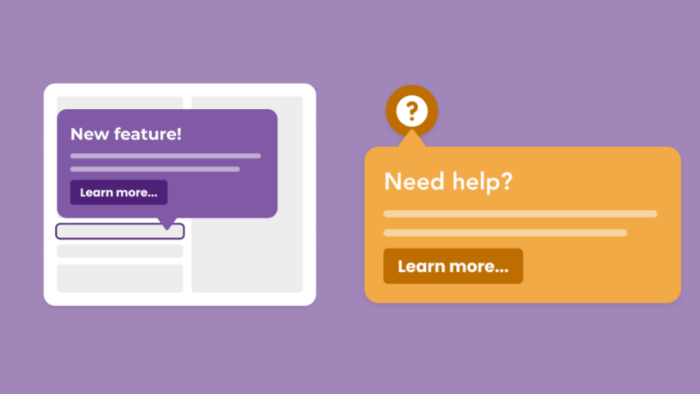A customer success (CS) team is the heart and soul of an organization—the eyes and ears on the ground when it comes to all things customer health.
CS teams are how you ensure you’re building a product that customers love using. From self-serve support to in-product feedback collection—customer success teams within a product-led growth (PLG) framework proactively work to improve your product experience.
But what’s the difference between customer success and customer support? It comes down to reactivity.
Customer support awaits customer issues to receive and respond to, whereas customer success preempts issues and ways to solve them in advance.
Put simply, customer support is reactive, and customer success is proactive.
In this article, you’ll learn about the importance of customer success managers for product-led growth and what you can expect them to work on in your organization.
Customer success teams ensure users have in-product, self-serve support options when and where they need them.
Customer success teams are proactive, and customer support teams are reactive.
Customer success managers need to collaborate with different departments across the organization.
CS team responsibilities include lowering churn and facilitating product adoption.
What is customer success in PLG?
Customer success in a product-led organization involves providing users with tech-led self-serve support and resources to help them best use your product. This includes self-serve user onboarding and engagement prompts—typically in the form of in-app messaging—that guide users within your product.
At the other end of the scale, the low-touch, product-led customer success approach is a high-touch, human-led way of supporting customers. Businesses operating a human-led customer success program take a one-on-one approach with customers—often referred to as a white glove CSM model.
They’re both effective, but tech-led user success management has a key advantage: it’s scalable. While human-led customer success teams need to hire and train new staff to support a growing user base, tech-led user success can be scaled with the click of a button.
Why do you need a customer success manager?
A customer success manager (CSM) focuses on building relationships with customers, understanding their needs, and guiding them to use products to their full potential.
Here’s a quick overview of what a CSM does:
Directs new users through an intuitive, in-app onboarding process to quickly realize the product's value
Recognizes when a customer might benefit from additional services or features and suggests upgrades
Gathers customer insights and feedback to inform product improvements
Anticipates and addresses potential challenges before they become issues for the customer
Keeps an eye on usage data to ensure customers are getting the most out of the product
Initiates and moderates forums or user groups to encourage peer-to-peer support and engagement within the user community

5 Reasons you need CSMs on your team
When adopting a product-led approach to growth, a proactive approach to customer success is an absolute must.
Here’s why.
1. Show the right message at the right time, in the right channel
Product-led customer success managers ensure that customers get the help they need when they need it. They identify friction points within the product to best provide contextual support.
This is also essential when converting free users into paying customers. Guiding free trial users toward that initial point of value turns them into product-qualified leads. The actions that turn a free user into a product-qualified lead differ from company to company, but it’s the customer success team that creates the in-product flows and product-led resources to guide them in the right direction.

Knowing when and how to give users in-product support is essential for product adoption, user retention, and product-led revenue growth. Without adequate guidance, you’re essentially giving them the keys to a brand new car without teaching them how to drive.
2. Nurture cross-team collaboration
Valuable insights come from all over an organization, and part of a customer success manager’s role is to collaborate with other teams to uncover these insights. They work with other disciplines to get all the necessary customer data to create the best initiatives to meet customer needs and promote user success.
Successful customer success management requires a multi-channel approach and cross-team collaboration at many stages of the process, with marketing, product, customer support, and more all getting involved.
For example, let’s say your CS team uses customer success tools—like feedback surveys and NPS— that reveal that users aren't fully aware of how to use one of your product’s advanced features.
The customer success team can use product analytics tools—like heatmaps and click tracking—to identify where exactly users are dropping off. They then ideate ways to solve the problem with well-placed in-product messages and flows.
They optimize these messages by working with the UX team—who look at the widget or pop-up design—and the marketing team—who ensure the messaging is consistent with the brand’s tone of voice and branding.
The end result? A well-written in-app message to point users in the right direction at a point where feedback indicates they typically drop off. Plus, if the best fix is a feature redesign—then so be it! The product team can be notified of issues and can develop a solution to avoid them altogether.
It’s not essential to follow this exact course, but you get what we mean—it takes a village. Customer success managers are the ones that own this process, and are responsible for coordinating its execution with other teams.
What to improve customer loyalty?
Check out our list of customer success tools and tactics to build user-centric products.
3. Share customer insights with everyone in your org
Customer success managers don’t just receive information, they also share it. The product and user insights collected by the customer success team can be greatly beneficial for other operations within the organization.
Here are some examples of what we mean:
Sharing product usage insights with sales helps them better pitch your product and its features to the different client personas.
Highlighting common pain points to the product development team helps them develop built-in solutions that avoid said pain points altogether.
Identifying features with high adoption rates across user personas helps marketing better highlight product value in communications.
You know what they say—knowledge is power. The insights collected by customer success managers empower other disciplines with the knowledge to make more informed decisions in their roles.
4. Combine qualitative and quantitative data
Your day-to-day operations generate both qualitative and quantitative customer data. You could get incredible feedback through customer support calls one day, and equally amazing insights from sales data another.
It’s the customer success team’s responsibility to combine, compare, interpret, and act on this information.
Customer success teams look at all user data—from product analytics data to customer feedback to in-app survey responses, and more—to get a holistic overview of customer satisfaction. They then use this information to create initiatives that increase adoption and give users the best possible product experience.
5. Shape the future of your product
The customer success team also plays a key role in shaping the future of your product. The insights they gather through in-app messaging engagement and micro survey feedback can help guide product development.
Identifying issues at a user level helps build a product that meets customer wants and needs. It’s product-led development, after all—product insights guide the product roadmap.
3 Pillars of the CSM role in PLG companies
So, what makes your PLG customer success team thrive?
While every business differs, here are three pillars that every great customer success manager should understand and promote.
1. Product as the main communication channel
Firstly, the CS team needs to understand how customer success works in product-led companies. It’s a unique approach to growth that relies on in-product communications to guide and support users.
CSMs in product-led customer success teams need to view and utilize the product as the main communication channel. They need to be strategic and resourceful with where, when, and how they use in-product messaging to gather feedback, unblock users, and help customers reach their aha! moment.
2. Customer feedback as the source of truth
Another key pillar in CS teams is that customer feedback is the ultimate source of truth. Customer success starts with understanding customer pain points and problems. This shouldn’t be a guessing game—the only way to accurately get insights into what customers want and need is to ask.
Useful and actionable customer feedback can come from a variety of sources—and requires cross-team collaboration. The CS team needs to proactively discuss customer pain points with other teams. They also need to look at their own data—obtained by running in-app surveys and product research initiatives—to uncover customer feedback.
How they do it isn’t the question, it’s whether they prioritize customers in the customer-centric approach employed in product-led businesses.
3. Product usage data as the key to insights
Product usage data is essential for proactively supporting customer success. It enables customer success teams to identify behavior patterns in the customer journey, prioritize developments on the product roadmap, refine key product features, and improve the overall user experience.
For example, a product-led customer success team might notice that a segment of users frequently uses a specific feature but hasn't adopted another complementary feature that could significantly enhance their workflow.
With this insight, the team can create personalized in-app messages or email campaigns targeting this user segment, guiding them to the underused feature and offering hands-on tutorials or assistance.
Although customer success teams aren’t responsible for all of the actions that result from product usage data, they are key in some of them. Along with other teams, the customer success team needs to find innovative ways to unblock users and reduce friction with in-app messaging.
3 Key responsibilities for CSM in product-led teams
Here are some of the tasks a customer success team is responsible for. These are the primary goals of a customer success team, and what they’ll work towards in your organization.
1. Measure customer health and satisfaction
A key task for the customer success team is to measure user satisfaction and health. While email surveys and user interviews are helpful, the in-app surveys and widgets used by customer success teams gather contextual, specific feedback.
Here are some of the ways a customer success team measures customer satisfaction:
Customer health score
The customer health score is a set of data points that determine how likely a customer is to churn. It’s typically guided by a scorecard—where customers fall into three categories:
Green: less likely to churn, more likely to increase and grow their contract with you
Yellow: may churn, or may be retained at the same contract with you
Red: at high risk of churning and potentially leaving a negative review
This scoring system enables you to identify customers at risk of churn so the CS team can proactively implement customer retention strategies.
Customer satisfaction survey
Customer satisfaction surveys are used to understand the level of customer satisfaction with your product, service, specific features, onboarding experience, or overall user experience throughout the product lifecycle.
They’re a great way to assess customer needs, understand expectations, and identify challenges customers face when using your product. Simply ask users: ‘How satisfied are you with XYZ?’, and offer a rating scale from ‘not satisfied at all’ up to ‘extremely satisfied’.

These surveys—along with others—help get a snapshot of customer health and satisfaction.
2. Help lower the churn rate and maximize adoption
A large portion of the customer success team’s day-to-day involves working toward helping lower churn and maximize product adoption. Product usage data and customer feedback are combined to identify and resolve user issues—ensuring your product is worth sticking around for.
Here’s how they do it:
Identify different user journeys: different users take different paths through your product. One user’s most-used feature is another’s least-used. The first step to lowering churn is identifying the user segments within your product.
Understand needs for each user segment: once the CS team has identified user segments, they can dive deeper into each for segment-specific insights. This helps them identify common issues and user preferences associated with each segment.
Optimize self-serve user onboarding: segments and their related insights help provide users with a self-serve onboarding experience that guides them towards their aha! moment as quickly as possible.
Personalize feature adoption flows: new users are categorized into an existing user segment to show them how to use the features that they’re most likely to benefit from.
It’s not one singular action that reduces churn, but a focused effort to provide a personalized and optimized experience to users. These efforts come from the customer success team.
3. Proactive feedback collection
Customer success teams also proactively gather user feedback with in-app microsurveys. These microsurveys are deployed to gather contextual insights by asking the right questions at the right time.
For example, you could trigger a brief in-app survey following the onboarding process to get users’ thoughts directly following flow completion. Not only are they more likely to complete the survey than if it were delivered via email, but you also get instant, context-specific feedback.

What do you need in your PLG customer success tech stack?
Your PLG customer success tech stack should empower your product teams to deliver a product-led go-to-market model by making the most of cross-team resources and customer and user data and implementing product changes based on findings.
For example, a product adoption platform like Chameleon helps your product-led growth customer success team run targeted in-product campaigns that can drive feature adoption and collect user feedback along the way.
So you need to ensure your tech stack includes capabilities for:
Styling and customization: makes every in-app message, guide or tutorial feel like a natural extension of your brand
Self-serve support for your customers: from day one, help customers help themselves with a curated list of resources, including links to detailed product walkthroughs, help documents, and video tutorials
NPS & Microsurveys: collect targeted, contextual feedback to understand user satisfaction and areas for improvement
Integrations with your tech stack: lets your customer success platform connect with other systems you already use—analytics, marketing, and sales
Customer success teams are winning with Chameleon in their tech stack. For example, The Motley Fool reduced churn by almost 10% within two months.
See how other Customer Success teams use Chameleon
Win buy-in with these insights into how Chameleon helps CS teams drive user engagement, improve onboarding, and reduce churn
Don’t underestimate the power of customer success and PLG
Customer success teams increase retention and product adoption by giving users the in-app support they need. They collaborate with other teams to identify issues, and use a variety of methods and tools to provide contextual guidance.
One key tool in a customer success manager’s arsenal is a product adoption solution, like Chameleon. Chameleon provides CS teams with the tools they need to deploy in-app solutions to user problems. Whether it’s in-app tooltips, product tours, microsurveys, or more—CS managers can better support users with the right tools.
Get in touch today to experience how Chameleon can help your team meet user needs.

Optimize customer success with product adoption
Give your CSMs the gift of product adoption tools for better retention
Product led growth customer success FAQs
-
Customer success teams contribute to a product-led growth model by ensuring users realize the full value of the product through proactive engagement and support. They collect and act on user feedback to guide product improvements, tailor onboarding experiences, and facilitate feature adoption.
-
For paying customers, the strategy focuses on providing full access, premium features, and personalized support. On the other hand, freemium users receive basic features with strategic limitations, encouraging them to upgrade for more value—highlighting what they're missing out on.
-
The benefits of PLG customer success include boosting user engagement by intuitively integrating with the user journey. It effectively reduces churn by quickly demonstrating the product's value, ensuring users recognize its benefits early on.
-
There are three. The high-touch model provides personalized, in-depth support for key accounts. The tech-touch (or low-touch) model leverages automation and self-service resources for scalability. The hybrid model blends personalized support with automated processes.






